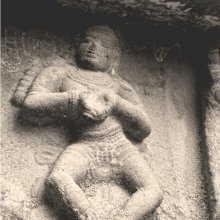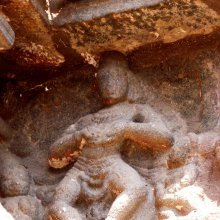Talasamsphotita, Talasaṃsphoṭita, Tala-samsphotita: 3 definitions
Introduction:
Talasamsphotita means something in Hinduism, Sanskrit. If you want to know the exact meaning, history, etymology or English translation of this term then check out the descriptions on this page. Add your comment or reference to a book if you want to contribute to this summary article.
Images (photo gallery)
In Hinduism
Natyashastra (theatrics and dramaturgy)
Source: Wisdom Library: Nāṭya-śāstraTalasaṃsphoṭita (तलसंस्फोटित).—One of the 108 karaṇas (minor dance movement) mentioned in the Nāṭyaśāstra chapter 4. The instructions for this talasaṃsphoṭita-karaṇa is as follows, “a foot to be swiftly lifted up and put forward, the two hands showing Talasaṃsphoṭita gesture.”.
A karaṇa represents a minor dance movements and combines sthāna (standing position), cārī (foot and leg movement) and nṛttahasta (hands in dancing position).

Natyashastra (नाट्यशास्त्र, nāṭyaśāstra) refers to both the ancient Indian tradition (shastra) of performing arts, (natya—theatrics, drama, dance, music), as well as the name of a Sanskrit work dealing with these subjects. It also teaches the rules for composing Dramatic plays (nataka), construction and performance of Theater, and Poetic works (kavya).
Shilpashastra (iconography)
Source: Archaeological Survey of India: Śaiva monuments at Paṭṭadakal (śilpa)Talasaṃsphoṭita (तलसंस्फोटित).—T. A. G. Rao defines talasaṃsphoṭita mode of dance as follows: “In this mode of dancing the dancer stamps vehemently the ground in front of him, with one of his feet lifted fairly high.” The author has illustrated this dance pose with one example from Kailāsanātha temple at Kāñcipuram and another at Chengunnūr, a Śiva temple in Travancore. (Elements of Hindu iconograpy vol. II, pt. 1, p. 268-269)
The latter image of Śiva is of multiple hands but one of his left hands is adorned with Nandidhvaja and the right uppermost with the ḍamaru. The position of legs and feet in this image is similar to the image under study. The position of legs, feet and the attributes make us to opine that the technical term talasasṃsphoṭita mūrti suits well to this image in spite of a few minor differences in the examples chosen by our author and the Paṭṭadakal statue.

Shilpashastra (शिल्पशास्त्र, śilpaśāstra) represents the ancient Indian science (shastra) of creative arts (shilpa) such as sculpture, iconography and painting. Closely related to Vastushastra (architecture), they often share the same literature.
Languages of India and abroad
Kannada-English dictionary
Source: Alar: Kannada-English corpusTalasaṃsphōṭita (ತಲಸಂಸ್ಫೋಟಿತ):—[noun] (dance) one of one hundred and eight coordinated movements of hands and feet, pushing one thigh apart and striking the floor with toes and the front portion of the foot (without the heel touching floor) and clapping with the palms of the hand.
Kannada is a Dravidian language (as opposed to the Indo-European language family) mainly spoken in the southwestern region of India.
See also (Relevant definitions)
Partial matches: Tala.
Full-text: Mattaskhalitaka, Nataraja.
Relevant text
Search found 3 books and stories containing Talasamsphotita, Talasaṃsphoṭita, Tala-samsphotita, Tala-saṃsphoṭita, Talasaṃsphōṭita, Talasamsphōṭita, Tala-samsphōṭita; (plurals include: Talasamsphotitas, Talasaṃsphoṭitas, samsphotitas, saṃsphoṭitas, Talasaṃsphōṭitas, Talasamsphōṭitas, samsphōṭitas). You can also click to the full overview containing English textual excerpts. Below are direct links for the most relevant articles:
The Religion and Philosophy of Tevaram (Thevaram) (by M. A. Dorai Rangaswamy)
Chapter 4.3 - (a) Nataraja (the dance of Shiva) < [Volume 2 - Nampi Arurar and Mythology]
Chapter 3.4 - Gajaha-murti (the story of killing Gajasura) < [Volume 2 - Nampi Arurar and Mythology]
Chapter 4.3 - (c) Sculptures of Shiva and Dance < [Volume 2 - Nampi Arurar and Mythology]
Natyashastra (English) (by Bharata-muni)
Pallava period (Social and Cultural History) (by S. Krishnamurthy)
Scheme of Pallava Sculptures < [Chapter 2 - Origin of Sculptural Art—Its Development and Scheme]

